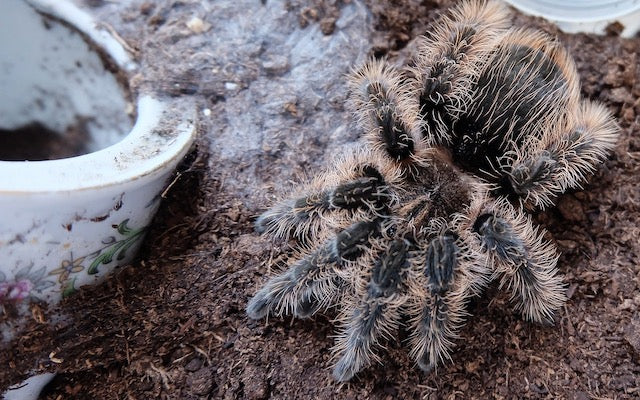Do tarantulas make webs? Yes. Tarantulas make webs. But tarantula webs aren’t the same as the webs of “true spiders.” Tarantulas don’t use their webbing to capture prey. Rather, they have a wide variety of uses for their webbing. Let’s explore.
Do Tarantulas Make Webs?
Many new T-keepers want to know, do tarantulas make webs? Do they web extensively? What do they use their webs for?
The short answer is yes, tarantulas make webs. However, tarantula webs are very different from their “true spider” cousins. The most obvious difference is that tarantulas don’t spin intricately woven and complex webs like true spiders. Compared to true spider webs, tarantula webs look like a chaotic mass of silk.
Tarantulas also don’t live on their webs like true spiders. Rather, they live in burrows that they line inside and outside with their silk webbing.
Finally, tarantulas don’t use their webs to capture prey like true spiders do. Tarantulas are hunters. They use their webs to sense possible prey, but they pounce on their prey rather than relying on the webbing to capture prey.
Tarantula Web Makes for a Cozy Home
Although tarantulas prefer to live in burrows instead of in intricately woven webs like their “true spider” cousins, they line their burrows from top to bottom with webbing. This provides some structural support to the burrow so that it doesn’t collapse in on them. It can also protect the burrow from being invaded by other insects.
Since arboreal tarantulas make their homes within dead trees or beneath a loose piece of tree bark, they run the risk of the bark being pulled away or the dead tree crumbling around them. To prevent this and provide some structural integrity to their home, they’ll use their webbing between the bark and the tree for additional strength.
Fascinating Fact: Spider webbing has a very high strength-to-weight ratio and is considered one of the strongest substances.
Tarantulas also use their webbing to create “molting mats.” These are a sort of carpet that the tarantula uses to make itself comfortable and reduce susceptibility to damage or injury during the molting process.
Tarantulas Hunt with Their Web
Also differing from their “true spider” cousins, tarantulas don’t spin webs to catch their prey. Rather, they’re opportunistic hunters, preferring to pounce on their prey the moment they sense its presence.
How do tarantulas sense the presence of possible prey? They use their web!
Tarantulas are very sensitive to the vibrations of their webbing. Many species will web extensively around the entry of their burrow as a sort of alarm system. When prey walks across this non-sticky webbing, the tarantula immediately knows that the cosmic DoorDash has just delivered its next meal.
This webbing will also warn the tarantula if there is a threat at its door.

Tarantula Web for Climbing Support
Believe it or not, despite their size and girth, tarantulas are actually very delicate. If they take a fall while climbing, they risk damaging their body or even rupturing their exoskeleton. Such injuries would make them very susceptible to predators, and tarantulas know it!
Using their silk for climbing gives them a better grip on the surface they’re climbing and reduces the risk of falling.
But here’s the incredible thing. Tarantulas don’t use the silk spun from the spinnerets in their abdomen. Rather, when climbing, tarantulas secrete silk from their feet – almost like Peter Parker shooting webbing from his hands!
Scientists at the University of Newcastle filmed a tarantula in a clear glass tank, tipping the tank on its edge to find out how the tarantula would stabilize itself. When they reviewed the video they were amazed to notice that the tarantula’s feet were the only part of its body that ever touched the surface.
After conducting a microscopic examination of the glass, they discovered that there were silk secretions in the tarantula’s footprints. This confirmed that tarantulas’ feet do indeed produce their own silk.
Tarantulas Use Their Webbing for Reproduction
In addition to using their webbing to improve the structural integrity of their burrows, sense the presence of prey, and stabilize themselves while climbing, tarantulas also use their silk webbing for reproduction.
Male tarantulas create what are known as “sperm webs.” When they’re ready to reproduce, but before they go out to search for a mate, male tarantulas create a web that they use to transfer their sperm cells to their palpal bulbs. After this process is complete, they quickly destroy the sperm web.
Most T-keepers never get the chance to see their male tarantula make a sperm web. The process is typically done at night and very secretively. At best you might discover a wadded up ball of tarantula webbing in your T’s substrate.
Sperm webs are only made after the male’s final molt, and are an indication that he is reaching the end of his life, as well as being ready to pass on his genes.
Female tarantulas also use their webbing for reproduction. When they’re ready to lay their eggs, they’ll create a silk bowl to cushion the eggs. She’ll then seal off the bowl, creating an egg sac to protect the eggs from potential damage.
The mommy T will rotate the sac several times a day to prevent the sac from laying too long on one side. Once the spiderlings are ready to hatch, they’ll make their own way out of the egg sac.
Takeaway: Tarantulas do make webs, but they use their webbing for different purposes than their true spider cousins. Tarantulas use their webs for lining their burrows, to track the movements of their prey, to aid their climbing, and as part of their reproductive process.








